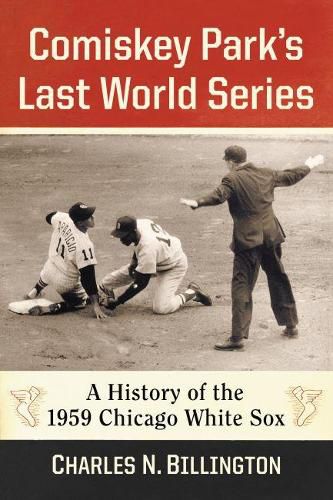Readings Newsletter
Become a Readings Member to make your shopping experience even easier.
Sign in or sign up for free!
You’re not far away from qualifying for FREE standard shipping within Australia
You’ve qualified for FREE standard shipping within Australia
The cart is loading…






This title is printed to order. This book may have been self-published. If so, we cannot guarantee the quality of the content. In the main most books will have gone through the editing process however some may not. We therefore suggest that you be aware of this before ordering this book. If in doubt check either the author or publisher’s details as we are unable to accept any returns unless they are faulty. Please contact us if you have any questions.
Comiskey Park’s Last World Series analyzes the significance of the 1959 White Sox from a multitude of perspectives. The book presents much more than the White Sox being one of the few teams modern era to win a pennant with speed, pitching, and defense.
The team is studied not just as a charter member of the American League but as a cultural institution that held a great deal of significance as this country’s last neighborhood professional franchise. The team’ historical importance to Chicago and the significance of the first South Side World Series in forty years is also covered in detail.
There is an analysis of the economic landscape of baseball during the Golden Age throughout the book, looking at the characteristics of media markets and the different ways teams tried to maximize them in that era. Bill Veeck’s unique and unusual theories about in-house promotions-everything from free giveaways to his theories about post-game fireworks- is discussed at length. The reader is also afforded an in-depth analysis of a team’s ancillary sources of revenue and how critical everything from concessions to stadium rentals were to a team’s bottom line during that era.
No other book on the 1959 White Sox discusses the bitter legal feud Charles Comiskey and Bill Veeck waged throughout the season with as much detail and insight as this work does. Also, little has been written about why this uniquely talented 1959 White Sox team did not repeat as champions. This book ends with an entire chapter on that subject.
$9.00 standard shipping within Australia
FREE standard shipping within Australia for orders over $100.00
Express & International shipping calculated at checkout
This title is printed to order. This book may have been self-published. If so, we cannot guarantee the quality of the content. In the main most books will have gone through the editing process however some may not. We therefore suggest that you be aware of this before ordering this book. If in doubt check either the author or publisher’s details as we are unable to accept any returns unless they are faulty. Please contact us if you have any questions.
Comiskey Park’s Last World Series analyzes the significance of the 1959 White Sox from a multitude of perspectives. The book presents much more than the White Sox being one of the few teams modern era to win a pennant with speed, pitching, and defense.
The team is studied not just as a charter member of the American League but as a cultural institution that held a great deal of significance as this country’s last neighborhood professional franchise. The team’ historical importance to Chicago and the significance of the first South Side World Series in forty years is also covered in detail.
There is an analysis of the economic landscape of baseball during the Golden Age throughout the book, looking at the characteristics of media markets and the different ways teams tried to maximize them in that era. Bill Veeck’s unique and unusual theories about in-house promotions-everything from free giveaways to his theories about post-game fireworks- is discussed at length. The reader is also afforded an in-depth analysis of a team’s ancillary sources of revenue and how critical everything from concessions to stadium rentals were to a team’s bottom line during that era.
No other book on the 1959 White Sox discusses the bitter legal feud Charles Comiskey and Bill Veeck waged throughout the season with as much detail and insight as this work does. Also, little has been written about why this uniquely talented 1959 White Sox team did not repeat as champions. This book ends with an entire chapter on that subject.